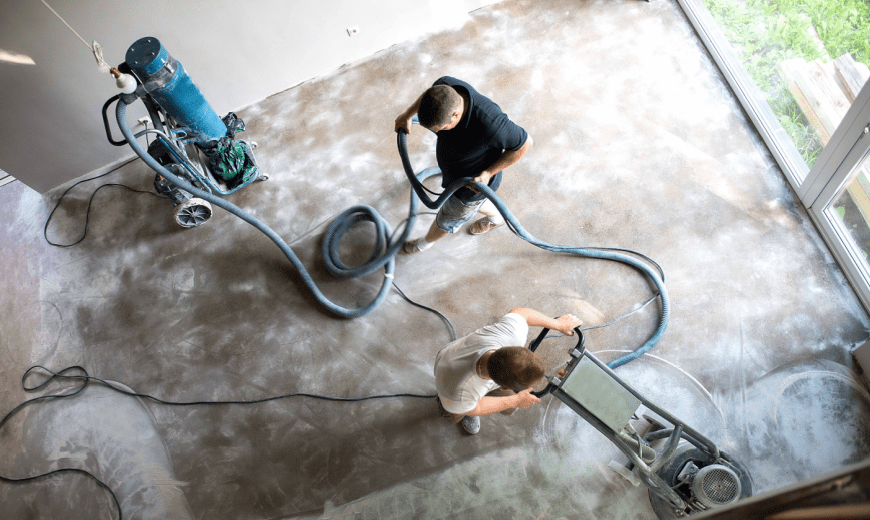Schleifen
Schleifen
Zur Untergrundvorbereitung von Bodenbelägen gehört unter anderem das Schleifen von Beton- und Estrichoberflächen. Dieses Verfahren ist besonders materialschonend und erzielt sehr gleichmäßige Ergebnisse, die kaum nachbearbeitet werden müssen. Der folgende Artikel zeigt, wie und warum Beton oder Estrich geschliffen wird und welche Vorteile das Schleifen gegenüber anderen Verfahren hat.
Wie funktioniert das Schleifen von Beton und Estrich?
Ein Schleifgerät für Beton und Estrich ist mit einem rotierenden Schleifteller ausgestattet, der von einem Motor in Bewegung gesetzt wird. Optimal sind Maschinen mit Diamantbeschichtung, da diese selbst harten Beton gut abschleifen können.
Bei dem Schleifen bewegt sich das Gerät horizontal auf der Oberfläche hin und her und schneidet mit einer bestimmten Körnung in den Boden ein, um diesen zu glätten. Hierbei sind Nivellierungsdistanzen von 1-2 Millimeter möglich. Für ein perfektes Ergebnis wird die Körnung mit jedem Durchgang verdoppelt.
Wichtig ist, dass das Schleifgerät kontinuierlich über den Boden bewegt und dabei ein gleichbleibender Druck ausgeübt wird, um ein gleichmäßiges Ergebnis zu erzielen. Ideal ist die Bewegung im Kreuzgang. Der dabei entstehende Staub sollte sofort abgesaugt werden, um gesundheitliche Belastungen zu verhindern.

Welchem Zweck dient das Schleifen von Estrich- und Betonböden?
Das Schleifen von Estrich- und Betonböden ist fester Bestandteil der Untergrundvorbereitung und dient sowohl praktischen als auch ästhetischen Zwecken. Hierfür sind oftmals mehrere Schleifdurchgänge nötig. Werden zwischen diesen Durchgängen Imprägnierungsmittel in den Betonboden eingebracht, kann das Schleifen das Versiegeln ersetzen.
Das Abschleifen kann aber beispielsweise auch notwendig sein, wenn der Estrich zu hoch ist und sich die Türen nicht mehr richtig schließen lassen.
Auch wenn der Estrich einen neuen Anstrich erhalten soll, ist es nötig, die Oberfläche vorher zu schleifen. Ebenfalls zu empfehlen ist das Schleifen vor dem Verputzen des Bodens. Durch die abgeschliffene, glatte Oberfläche muss die Putzschicht nicht mehr so dick sein, was sowohl Arbeit als auch Kosten einspart.
Welche Vorteile bietet das Schleifen von Beton und Estrich gegenüber anderen Verfahren?
Wenn nur geringe Mengen Material abzutragen sind, sodass kein Fräsen erforderlich ist, reicht das Schleifen von Beton oder Estrich aus. Dabei bringt es einige Vorteile gegenüber anderen Verfahren mit: Schleifen ist unter anderem deutlich materialschonender als Fräsen, denn das Gerät dringt hier nicht so tief in den Beton / Estrich ein. Deshalb ist es auch nicht nötig, dass anschließend ein Beton-Neuaufbau erfolgen muss.
Gleichzeitig lassen sich durch das Schleifen sehr gute Haftzugwerte und eine hohe Scherfestigkeit erzielen und auch die Oberflächenoptik ist – im Vergleich zum Kugelstrahlen – besser. Durch die große Bearbeitungsbreite moderner Schleifmaschinen lässt sich eine große Flächenleistung pro Stunde erzielen, ohne dass unschöne Strahl- oder Fräsbahnen entstehen.
Seit über 25 Jahren Fachbetrieb für Beton- und Estricharbeiten
Die Untergrundvorbereitung von Bodenbelägen gehört zu den Hauptaufgaben in unserer Firma für Beton- und Estricharbeiten. Unsere Mitarbeiter verfügen über umfassende Expertise und langjährige Erfahrung und sorgen für eine schnelle und professionelle Umsetzung der Untergrundvorbereitung, damit Ihr Projekt zügig voranschreiten kann. Vereinbaren Sie einfach einen Termin für ein Beratungsgespräch und teilen Sie uns mit, wie wir Ihnen helfen können. Wir freuen uns, mit unserer Arbeit zu Ihrem neuen Boden beitragen zu können.
Fragen und Antworten über das Schleifen
Ziel des Anschleifens ist es, dem Estrich eine haftfähige Oberfläche zu verleihen, auf der ein Bodenbelag (mit Klebstoff) fixiert werden soll. Hierfür kommt in der Regel eine Einscheibenmaschine (z. B. mit 16er Korn) zum Einsatz, die loses Material entfernt und die Oberfläche anraut. Befinden sich dagegen Unebenheiten im Estrich, muss dieser - zum Beispiel mit einem sogenannten Diamantrotierteller - abgeschliffen werden. Das Abschleifen dient der Glättung von Unebenheiten und der Entfernung von leichten Verunreinigungen an der Oberfläche. Neben Sicherheitsaspekten sind hier vor allem ästhetische Aspekte ausschlaggebend.
Erst nach der vollständigen Austrocknung und Abbindung ist es möglich, einen neuen Betonboden zu schleifen. Dies kann - je nach Zusammensetzung des Betons - bis zu 4 Wochen dauern. Alte Betonböden sind jederzeit schleiffähig, sie sollten sich nur in einem besenreinen Zustand befinden.
Da er der alleinige Bodenbelag ist, muss Sichtestrich grundsätzlich immer geschliffen werden. Nur durch das Abschleifen lassen sich beispielsweise die Muster optimal hervorbringen, die bei der Verwendung verschiedener Farbzemente entstehen. Um eine ästhetisch ansprechende Oberfläche zu erhalten, sind oft mehrere Arbeitsgänge nötig: Nach dem Fräsen erfolgt das Abschleifen mit unterschiedlicher Körnung, die im Idealfall mit jedem Durchgang verdoppelt wird (Beispiel: Durchgang 1: Körnung 160, Durchgang 2: Körnung 320)
Die Kosten werden üblicherweise pro Quadratmeter berechnet und hängen von dem Arbeitsaufwand ab. Wenn wir Sie bei Ihrem Projekt unterstützen können, erstellen wir Ihnen gerne nach einem persönlichen Beratungsgespräch ein individuelles Angebot. Kontaktieren Sie uns hierfür einfach telefonisch oder per E-Mail.


